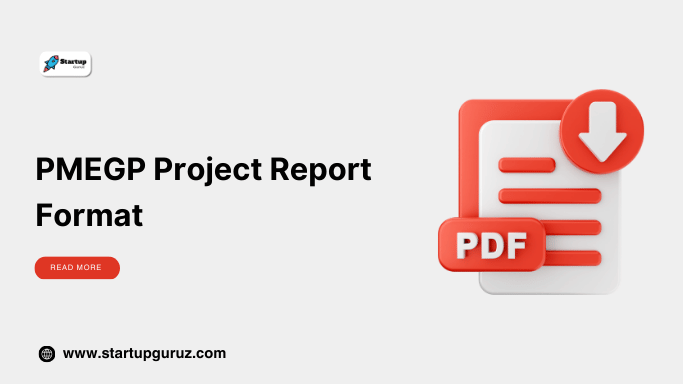PMEGP Project Report Format
PMEGP Project Report Format: A Complete Guide
Introduction
The Prime Minister’s Employment Generation Programme (PMEGP) is a government-backed scheme that helps individuals and small businesses secure financial assistance for setting up new enterprises. To avail of this scheme, a well-structured PMEGP project report is mandatory.
A properly formatted PMEGP project report helps in obtaining bank loans, subsidies, and government approvals. This guide provides a detailed PMEGP project report format, covering essential sections, financial projections, and FAQs.

What is PMEGP?
The Prime Minister’s Employment Generation Programme (PMEGP) is a credit-linked subsidy scheme implemented by the Khadi and Village Industries Commission (KVIC). It aims to generate self-employment opportunities by providing financial aid to micro and small enterprises in rural and urban areas.
Key Features of PMEGP:
✔ Loan up to ₹50 lakh for manufacturing units
✔ Loan up to ₹20 lakh for service and business enterprises
✔ 15%–35% subsidy on project cost
✔ Applicable to new businesses and startups
✔ Implemented by KVIC, KVIB, and DIC
Importance of a PMEGP Project Report
A PMEGP project report is a critical document required to secure a loan and subsidy under the PMEGP scheme.
Why is it Important?
✔ Acts as a blueprint for the business
✔ Provides financial and operational details
✔ Required for bank loan approval
✔ Helps in subsidy allocation
✔ Ensures smooth execution of the business plan
PMEGP Project Report Format
A PMEGP project report should be well-structured, concise, and include the following sections:
1. Cover Page
- Project Name
- Business Type (Manufacturing/Service)
- Applicant Name
- Contact Details
- Submission Date
2. Executive Summary
- Overview of the business idea
- Objectives and expected outcomes
- Total investment and financial assistance required
3. Business Description
- Type of business (Manufacturing/Service/Trading)
- Location and target market
- Legal structure (Proprietorship, Partnership, etc.)
4. Market Analysis
- Industry overview
- Demand and supply analysis
- Competition and pricing strategy
5. Organizational Structure
- Ownership details
- Roles and responsibilities of key team members
6. Financial Details
- Total project cost
- Loan and subsidy details
- Working capital requirements
7. Funding Requirements & Sources
- Own capital investment
- Bank loan details
- Government subsidy under PMEGP
8. Financial Projections
- Estimated revenue
- Profit & Loss statement
- Break-even analysis
9. Loan Repayment Plan
- Loan tenure and interest rate
- Monthly EMI details
10. Risk Analysis & Management
- Business risks and mitigation strategies
- Contingency plans
11. Conclusion & Recommendations
- Summary of financial viability
- Growth potential and expansion plans
Step-by-Step Guide to Prepare a PMEGP Project Report
Step 1: Research & Gather Information
Collect details about your business idea, industry, market demand, and competition.
Step 2: Define Business Objectives
Clearly state short-term and long-term goals of your business.
Step 3: Estimate Financial Requirements
Calculate total project cost, investment required, and expected revenue.
Step 4: Draft the Report
Follow the PMEGP project report format and include all necessary sections.
Step 5: Review & Finalize
Ensure accuracy in financial projections, grammar, and formatting.
Sample PMEGP Project Report Format
Project Name: Dairy Farming Business
Prepared By: XYZ Agro Pvt. Ltd.
Submission Date: March 2025
Executive Summary
XYZ Agro Pvt. Ltd. aims to establish a dairy farming unit to produce and sell milk and dairy products. The total project cost is ₹25 lakh, with a PMEGP loan of ₹20 lakh.
Market Analysis
- Growing demand for fresh dairy products
- India’s dairy market is expected to grow at 10% annually
Financial Overview
- Total Investment: ₹25 lakh
- PMEGP Loan: ₹20 lakh
- Own Investment: ₹5 lakh
- Annual Revenue Estimate: ₹30 lakh
Loan Repayment Plan
- Loan Amount: ₹20 lakh
- Interest Rate: 7% per annum
- Repayment Tenure: 7 years
- EMI: ₹30,000 per month
Risk Analysis & Mitigation
- Risk: Seasonal demand fluctuations
- Solution: Diversify product range to include cheese and butter
Conclusion
The project is financially viable, with strong market demand and government support through PMEGP.
Best Practices for PMEGP Project Report Preparation
✔ Use a professional format with clear sections
✔ Ensure accurate financial calculations
✔ Highlight project feasibility and profitability
✔ Customize the report for different business sectors
✔ Attach supporting documents like GST registration, business license, etc.
Frequently Asked Questions (FAQs)
1. What is the PMEGP scheme?
PMEGP (Prime Minister’s Employment Generation Programme) is a government subsidy scheme that helps individuals start small businesses by providing financial assistance.
2. What is the maximum loan amount under PMEGP?
The maximum loan amount is ₹50 lakh for manufacturing and ₹20 lakh for service-based businesses.
3. Is a project report mandatory for PMEGP?
Yes, a detailed project report is required for loan approval and subsidy allocation under PMEGP.
4. How can I apply for a PMEGP loan?
You can apply online through the KVIC PMEGP portal or visit your nearest DIC (District Industries Centre).
5. What documents are required for a PMEGP project report?
- Business plan
- Financial projections
- Identity proof
- Bank details
- GST registration (if applicable)
6. Can existing businesses apply for PMEGP?
No, PMEGP loans are available only for new business ventures.
7. What is the subsidy percentage in PMEGP?
- Urban areas: 15% for general category, 25% for SC/ST/OBC
- Rural areas: 25% for general category, 35% for SC/ST/OBC
8. How long does it take for PMEGP loan approval?
It usually takes 30-90 days, depending on the bank and document verification process.
9. Can I prepare the project report myself?
Yes, but it is recommended to take professional help to ensure accuracy and compliance with bank requirements.
10. Where can I find a sample PMEGP project report?
You can download sample reports from the KVIC website, MSME portals, or business consultancy services.